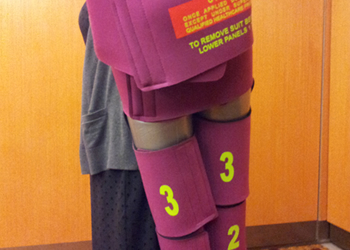IPP Media.com reports back from Women Deliver in Kuala Lumpur. Their article on the NASG highlights use in Tanzania and other African countries.
Technological device helps in war against maternal mortality
By Joana Mantey
12th June 2013
 The anti shock garment has been successfully piloted in Tanzania, Nigeria and Burundi with positive results.
The anti shock garment has been successfully piloted in Tanzania, Nigeria and Burundi with positive results.
Having a medical problem during pregnancy can be stressful, even fatal under dire circumstances. However, knowing the solution and applying it at the right time can help save the lives of many.
And that is what a new technological innovation known as Non Pneumatic Anti-shock garment (NASG) has been modeled for; to save the lives of women who experience excessive bleeding after child birth.
Such occurrences are common in poor communities where women tend to give birth at home because health care is ether not available or inaccessible. The onset of bleeding under such circumstances may lead to shock, organ failure or death.
Medical experts refer to that condition as Post Partum Hemorrhage, an ailment recognized as one of the leading causes of maternal deaths worldwide. Globally, it accounts for a quarter of all maternal mortally cases but in some African countries the rate could be higher such as 59% for Ivory Coast and 43% for Guinea.
In most rural settings nothing much can be done about such conditions. However, the anti shock garment helps to manage such bleeding episodes until adequate help can be sought from health providers.
The device works by applying pressure to the lower half of a woman’s body until she is carried to a health facility for specialized care by trained personnel.
“When in shock, the brain, heart and lungs are deprived of oxygen because blood accumulates in the lower abdomen and legs.
The NASG reverses shock by returning blood to the vital organs. This will restore the woman’s consciousness, pulse and blood pressure. Additionally, the NASG slows blood flow to the lower body and decreases bleeding,” the Safe Motherhood Program, one of the leading organizations involved in the development of the garment explained.
The underlying principle of the garment evolved from suit originally designed by space agency NASA for astronauts. Joint research by health experts, including Pathfinder International, University of California and the Safe Motherhood Program has helped in adapting the technology to check injuries occasioned by bleeding in women. Data suggests that the innovation can reduce the incidence of hemorrhage in pregnancy by up to 50 per cent.
“These types of innovations and unique collaborations are the key to providing access to life saving solutions to women around the world,” Amie Batson, Chief Strategy Officer at PATH said at a recent conference on health and women’s empowerment in Malaysia dubbed “Women Deliver”.
“We have policy approval from the WHO. The challenge is to ensure it is available for use by women,” she added
The garment has been successfully piloted in Tanzania, Nigeria and Burundi with positive results.
However, it is important that adequate preparations are put in place for meaningful impact before it is fully rolled out nation-wide in Tanzania.
In the first place, policy makers must create the right environment to encourage use of the garment. It is not just adequate to have an innovation targeting low resource communities. It is equally important to step up educational campaigns to whip up support throughout the country. Women leaders in communities have defined roles to play here as far as acceptance and use of the garment is concerned.
Workshops organized by PATH two years ago during which health workers from two refugee camp hospitals in Kasulu District, Tanzania received training on the anti shock garment must be extended to other areas. Ordinary community members must benefit from such exercises too. There is also need to educate community leaders on ways of recognizing complicated pregnancy cases that may end in bleeding so help can be sought early.
The non-pneumatic anti shock garment is a first aid device and not a definitive treatment for women suffering hemorrhage. Therefore it is important that an adequate system is put in place to facilitate transport of patients to hospitals for emergency obstetric care without delay.
* Joana Mantey is a Ghanaian journalist
